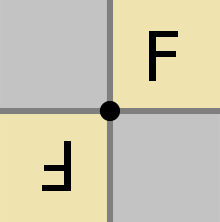This article needs additional citations for verification. (May 2024) |

In geometry, a point reflection (also called a point inversion or central inversion) is a geometric transformation of affine space in which every point is reflected across a designated inversion center, which remains fixed. In Euclidean or pseudo-Euclidean spaces, a point reflection is an isometry (preserves distance).[1] In the Euclidean plane, a point reflection is the same as a half-turn rotation (180° or π radians), while in three-dimensional Euclidean space a point reflection is an improper rotation which preserves distances but reverses orientation. A point reflection is an involution: applying it twice is the identity transformation.
An object that is invariant under a point reflection is said to possess point symmetry (also called inversion symmetry or central symmetry). A point group including a point reflection among its symmetries is called centrosymmetric. Inversion symmetry is found in many crystal structures and molecules, and has a major effect upon their physical properties.[2]
- ^ "Reflections in Lines". new.math.uiuc.edu. Retrieved 2024-04-27.
- ^ Cite error: The named reference
:0was invoked but never defined (see the help page).

